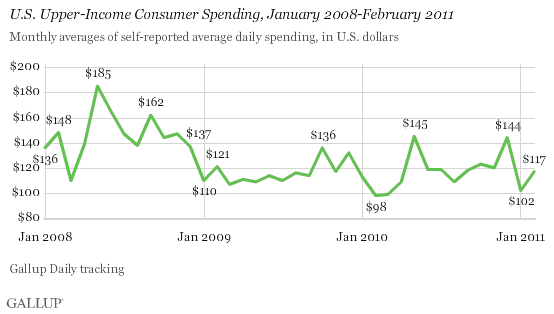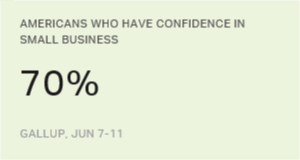PRINCETON, NJ -- Overall self-reported daily consumer spending in stores, restaurants, gas stations, and online averaged $61 per day in February. That is up slightly from $58 in January and $59 in February 2010, but still in the 2009-2010 "new normal" spending range and far below the $106 average of February 2008.

Throughout 2010, consumer spending remained relatively close to that of 2009. Spending surged each year in December as expected, given seasonal spending trends and that Gallup spending data are not seasonally adjusted. In January and February 2011, consumer spending returned to the 2009-2010 new normal spending range of $58 to $68.
Upper-Income Spending Increased in February, but Also Remains in New Normal Range
Upper-income Americans (those making $90,000 or more annually) spent an average of $117 per day in February -- up from $102 in January and $98 in February 2010 -- but about the same as the $121 of February 2009. These Americans, who have the disposable income to spend more freely when they choose, appear to have chosen to keep their spending within the 2009-2010 upper-income new normal range of $98 to $123 and far below the $148 average of February 2008.

Lower- and Middle-Income Spending Up Slightly, but Also in New Normal Range
Lower- and middle-income Americans' self-reported spending averaged $52 per day during February -- up slightly from $50 in January but down slightly from $55 in February 2010. Spending by these Americans making less than $90,000 a year remains far below the $95 average of February 2008.

Surging economic confidence during January and early February combined with new highs on Wall Street to provide some optimism that consumer spending and underemployment would follow suit. However, Gallup's data for the first two months of 2011 show that has not been the case. Consumer spending remains mired in the 2009-2010 new normal spending range. Even the modest increase in upper-income spending in February could not exceed this group's average February 2009 spending.
Higher gas prices, battles over the federal and state budgets, and one in five Americans remaining underemployed have led to a sharp decline in consumer optimism during recent weeks. While higher prices at the pump result in increasing consumer spending on gas, middle- and lower-income consumers often pull back on their other spending as fuel prices rise, resulting in an overall decline in total spending. Regardless, it seems unlikely that consumer spending trends will improve in the immediate term facing the current economic headwinds.
This is not good news for those retailers hoping 2011 would get off to a much better start during the first quarter. Nor is it good news for the overall U.S. economy, particularly if gas prices continue to increase. It was surging fuel prices in 2008 that started the recession that many Americans feel has yet to end.
Gallup.com reports results from these indexes in daily, weekly, and monthly averages and in Gallup.com stories. Complete trend data are always available to view and export in the following charts:
Daily: Employment, Economic Confidence and Job Creation, Consumer Spending
Weekly: Employment, Economic Confidence, Job Creation, Consumer Spending
Read more about Gallup's economic measures.
View our economic release schedule.
Survey Methods
Results are based on telephone interviews conducted as part of Gallup Daily tracking during the month of February 2011, with a random sample of 13,349 adults, aged 18 and older, living in all 50 U.S. states and the District of Columbia, selected using random-digit-dial sampling.
For results based on the total sample of national adults, one can say with 95% confidence that the maximum margin of sampling error is ±1 percentage point.
Interviews are conducted with respondents on landline telephones and cellular phones, with interviews conducted in Spanish for respondents who are primarily Spanish-speaking. Each daily sample includes a minimum quota of 200 cell phone respondents and 800 landline respondents, with additional minimum quotas among landline respondents for gender within region. Landline respondents are chosen at random within each household on the basis of which member had the most recent birthday.
Samples are weighted by gender, age, race, Hispanic ethnicity, education, region, adults in the household, cell phone-only status, cell phone-mostly status, and phone lines. Demographic weighting targets are based on the March 2010 Current Population Survey figures for the aged 18 and older non-institutionalized population living in U.S. telephone households. All reported margins of sampling error include the computed design effects for weighting and sample design.
In addition to sampling error, question wording and practical difficulties in conducting surveys can introduce error or bias into the findings of public opinion polls.
For more details on Gallup's polling methodology, visit https://www.gallup.com/.
